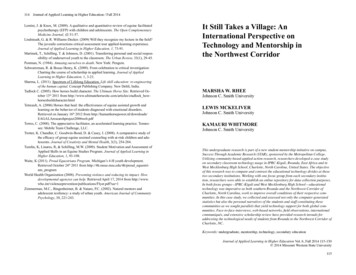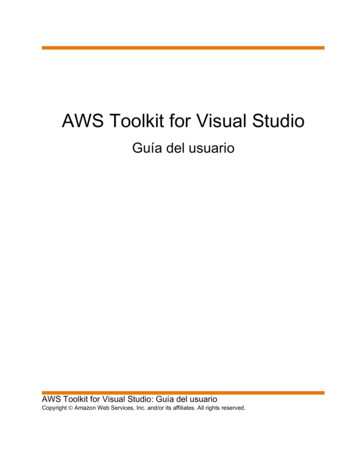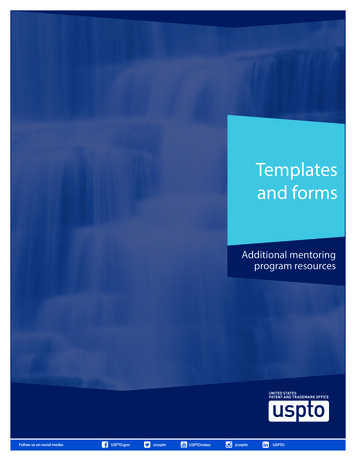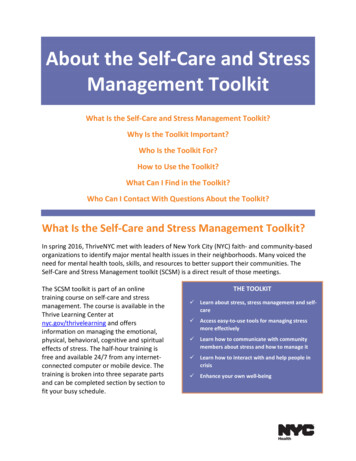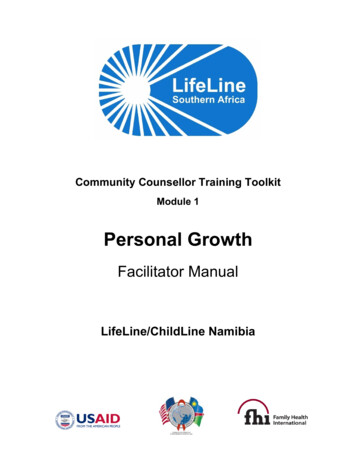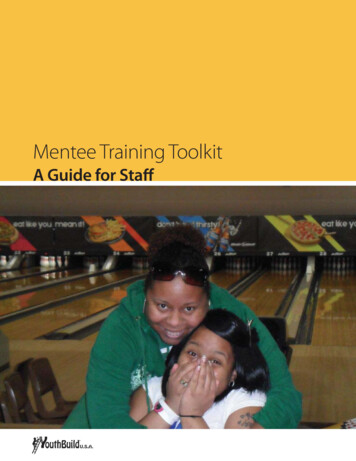
Transcription
Mentee Training ToolkitA Guide for Staff
ContentsIntroduction . . . . . . . . . . . . . . . . . . . . . . . . . . . . . . . . . . . . . . . . . . . . . . . . . . . . . . . . . . . . . . . . . . . . . . . . . . . . . . .1Training Effectiveness Evaluation Tool Instructions, Templates, and Scoring . . . . . . . . . . . . . . . . . . . . 4Minute-by-Minute Trainer Reference. . . . . . . . . . . . . . . . . . . . . . . . . . . . . . . . . . . . . . . . . . . . . . . . . . . . . . . .12Master List of Required Training Materials and Resources. . . . . . . . . . . . . . . . . . . . . . . . . . . . . . . . . . . . . 14Facilitator Notes and Handouts . . . . . . . . . . . . . . . . . . . . . . . . . . . . . . . . . . . . . . . . . . . . . . . . . . . . . 17Session 1: Introduction to YouthBuild Mentoring. . . . . . . . . . . . . . . . . . . . . . . . . . . . . . . . . . . . . . . . . . . . . 19Session 2: Mentoring in Action . . . . . . . . . . . . . . . . . . . . . . . . . . . . . . . . . . . . . . . . . . . . . . . . . . . . . . . . . . . . . . 39Session 3: Mentoring Connections. . . . . . . . . . . . . . . . . . . . . . . . . . . . . . . . . . . . . . . . . . . . . . . . . . . . . . . . . .51Session 4: Mentoring Strategies and Supports . . . . . . . . . . . . . . . . . . . . . . . . . . . . . . . . . . . . . . . . . . . . . . . 69
IntroductionWelcome to the Mentee Training Toolkit! This toolkit will allow your YouthBuild mentoring programto deliver a high-quality pre-match training for your students that will prepare them for the mentoring experience and give them relationship skills that will last a lifetime.The orientation and training of mentees is one of the most critical, yet often overlooked, aspects ofrunning a successful YouthBuild mentoring program. There are many reasons why this preparation isso important: It builds enthusiasm among participants, getting students excited about having some extra supportas they go through the YouthBuild experience. It answers student questions and helps overcome their fears about the experience. Let’s face it: Having a mentor is not something that comes naturally to most young people. A good training experience beforehand can reduce anxiety and provide key information about what it will be like. It provides skills that will help with the growth of their mentoring relationship and, hopefully,other relationships during their lifetime. You will notice that much of the content in this training isfocused on fostering good communication skills, setting goals, asking for help, respecting boundaries, and developing other skills that support other relationships. It sets expectations. A good prematch training makes roles and responsibilities clear, avoiding misunderstandings and relationship hiccups down the road. It provides a big-picture context for the mentoring relationship and how it fits into the other aspects of YouthBuild. Mentoring is a unique and important component of your YouthBuild programand this training helps students understand how this experience will be integrated with the rest ofyour YouthBuild program services.In addition to supporting your students, this toolkit should also help with one of the main tasksfacing a mentoring coordinator: developing the content and materials of the training itself. Puttingtogether a robust training is a lot of work. The slides and other materials provided here give coordinators a head start on developing quality training for their prospective mentees. While we encouragecoordinators and other staff to customize these materials for local use as they see fit, they can also usethem as-is with minimal additions (such as adding your own program name to the opening slides).We feel this will save coordinators considerable time and improve the consistency and quality ofmentee training across YouthBuild sites.Components of the ToolkitThis toolkit consists of the following files and downloads, all of which are available s: PowerPoint slides for each of the four Sessions in the training (available as separate files). This Guide for Staff, which provides an overview of the training, facilitator notes for each slide(along with tips for customizing the materials), tools and instructions for scoring and administering the Training Effectiveness Evaluation Tool, and a master copy of every handout you will needto conduct the training. The Ready for Mentoring guide, which serves as a supplemental resource you can refer to duringthe training. The Ready for Mentoring guide can also be referenced throughout the year by students as they work on their mentoring relationships. Provide each student with a printed copy and1
be prepared to refer to this valuable resource early and often as you prepare your mentees. (Thisresource can be downloaded on the Community of Practice at http://youthbuildmentoringalliance.org/webfm send/129.)Using the Facilitator’s GuideThe mentee training detailed here is composed of 4 one-hour sessions: Session 1: Introduction to YouthBuild Mentoring. This session lays the groundwork for the restof the training by explaining what a mentor is, how a mentor can support the YouthBuild experience, and the basics of participating in the program. Ideally, this session will get your studentsexcited about having a mentor and eager to learn more. Session 2: Mentoring in Action. This session digs deeper into what having a mentor is really like.It reviews participant roles and responsibilities, illustrates what good mentoring looks like, andreviews the types of activities and events mentors and students will engage in during the program. Session 3: Mentoring Connections. This session builds skills that will help the relationship getoff to a good start and grow over time. The focus here is on fostering good communication skills,building trust, and exploring the possibilities (and limits) of the mentoring relationship. Session 4: Mentoring Strategies and Supports. This final session highlights several strategies forgetting the most out of a mentor, tips for overcoming relationship hurdles, and final preparationsfor beginning the program.Although the training is presented here as four distinct hour-long sessions, facilitators should feelfree to schedule and sequence the training in whatever ways work best for their YouthBuild site andstudents.Options include: 1 four-hour (half-day) training 2 two-hour sessions Shorter half-hour sessions that highlight a few concepts or activitiesRegardless of how a site chooses to schedule the training, YouthBuild USA still expects that all mentees will go through the full four-hour training provided here before beginning their interactions withmentors. Ideally, all of this content will be delivered to mentees before the three-month period ofgroup mentoring that begins the mentoring cycle for each cohort.Working with the Files PowerPoint slides. The slides provided here are standard PowerPoint files that should work on anyWindows or Mac computer. There is a master slide for the title slide and second-level slides thatfacilitators can edit as they see fit. We have kept the fonts and colors to standard Windows/PowerPoint options for ease of customization.We encourage programs to add their own logos and contact information to the slides, insert photographs of their own students or mentees from previous years, and generally make these slides theirown. What is important is that you feel comfortable with the presentation of the content and theway the slides visually represent your program and mentoring philosophy. Facilitator notes. Starting on page 17 of this guide, you will find detailed notes for the persondelivering the training sessions. Text in italics indicates content that the facilitator should say to2
the group. Training notes are grouped by the four sessions. For each slide you will present, we haveprovided:– A thumbnail view of the slide– Slide title and number– Suggested timing to deliver the slide content or conduct the activity referenced– A list of handouts or materials– Tips for customizing the slide content– Instructions on delivering the content or activity (for some we have provided a sample scriptthat you can follow; for others we simply recommend key points to emphasize with participantsor options for altering the delivery to meet your audience needs)We encourage you to review the trainer notes thoroughly and customize them to match your delivery and personal style. If you need to alter the trainer notes considerably, you may want to transferthe content to Word or another word processing program. You can do this easily by copying andpasting text out of this PDF or by using the Export Tool in Adobe Reader and converting the entiredocument to Word format. Handouts. All of the handouts to deliver each session appear immediately after the facilitatornotes, grouped by session. This should make it easy to find the materials you need to deliver eachsession. As with the slides and facilitator notes, you can customize the handouts to meet the needs(or match the branding) of your local YouthBuild program. Other resources. As noted above, you can also use theReady for Mentoring guide as a general supplementto this training. We recommend providing a copy toeach mentee. While full customization of this resourcewould be time consuming, you may want to take specific sections or worksheets and turn them into trainingcontent if you think it would improve the training.Popular Movies with Mentoring ThemesAntwone Fisher – www.imdb.com/title/tt0168786/Chariots of Fire – www.imdb.com/title/tt0082158/Coach Carter – www.imdb.com/title/tt0393162/Dead Poets Society – www.imdb.com/title/tt0097165/Movies and video are powerful tools for training. Consider sprinkling in some clips before, during, or afterthe training sessions.Finding Forrester – www.imdb.com/title/tt0181536/You will find several videos about mentoring on theYouthBuild Mentoring Community of Practice thatyou may want to use as part of the training, especiallyduring the first two sessions as they provide the mostinformation about what the experience is like. Thesevideos offer heartwarming testimonials from studentsand mentors about their relationships and the valuethey have found in the program. The videos can helpnew students see that this is an opportunity someonelike them can really engage in, and it can help put a“face” on this abstract concept called mentoring.The Karate Kid – www.imdb.com/title/tt1155076/Forever Strong – www.imdb.com/title/tt0840322/The Lion King – www.imdb.com/title/tt0110357/Mr. Holland’s Opus – www.imdb.com/title/tt0113862/Remember the Titans – www.imdb.com/title/tt0210945/Role Models – www.imdb.com/title/tt0430922/Stand and Deliver – www.imdb.com/title/tt0094027/You may also find clips from movies with a mentoring theme useful for training. Feel free to incorporate these as needed before, during, or after the training sessions.3
Training Effectiveness Evaluation Tool InstructionsWhat is the Training Effectiveness Evaluation Tool?This is a level 2 evaluation tool, designed to measure knowledge gained from training. This tool willassess the level of participant knowledge prior to the training and the level of participant knowledgeafter the training.This tool is not designed to measure people’s feelings about the training, trainers, or the YouthBuildprogram, nor is it designed to measure someone’s readiness or suitability.How do I use the Training Effectiveness Evaluation Tool?You will administer this survey twice: once before the training begins (pre-test) and once at the endof the training series (post-test).Pre-Test:It is important to get accurate results, so please make sure participants complete this survey BEFOREthey receive any of the training materials or begin the training session.Before you begin the welcome portion of the training session, give a paper copy of the TrainingEffectiveness Evaluation Pre-Test survey to each person in your training group with these verbalinstructions:Before we begin, we’d like to ask you to complete a brief survey that will help us evaluate the effectiveness of this training. This survey is anonymous, so please do not put your name on it. This surveyshould be completed individually, so we ask that you refrain from talking among yourselves until thesurvey is collected. The results of this survey will be used to evaluate the effectiveness of our training,not your effectiveness or readiness as a mentee, and it will not impact your standing as a student inYouthBuild. Please make sure you read the directions and answer the questions to the best of yourability. At the end of the training series, you will be asked to take another survey to complete thisevaluation process.Post-Test:At the end of the training series, give a paper copy of the Training Effectiveness Evaluation Tool PostTest survey to each person in your training group with these verbal instructions:We’d now like to complete the evaluation process by having you retake the survey you completed at thebeginning of this training. Please remember that this survey is anonymous, so do not put your nameon it. This survey should be completed individually, so we ask that you refrain from talking amongyourselves until the survey is collected. The results of this survey will be used to evaluate the effectiveness of our training, not your effectiveness or readiness as a mentee, and it will not impact your standing as a student in YouthBuild. Please make sure you read the directions on the survey and answer thequestions to the best of your ability.Give participants three to five minutes to complete the survey. If participants ask questions aboutthe survey, do not give them the answers to the questions. When everyone has finished, collect thesurveys.4
How do I calculate the Training Effectiveness Evaluation Tool results?Once participants have the completed pre-tests and post-tests, you can calculate the results. Using theTraining Effectiveness Evaluation Tool Answer Key, go through each survey and circle every question that was marked correctly. Count the number of correct answers for question 1 on each pre-test,add them together, and enter the total number of correct answers in the corresponding column onthe Training Effectiveness Evaluation Tool Scoring and Calculation Guide. Repeat this process bycounting the number of correct answers for each question on each test and entering the total into thecorresponding column for questions 2 through 10. Complete the same process for the post-test questions 1 through 10.Once you have tallied all the correct answers for each question, you can calculate the percentage ofincrease in knowledge by using the formula described in Step 2 of the Training Effectiveness Evaluation Tool Scoring and Calculation Guide.What do I do with the Training Effectiveness Evaluation Tool results?Add your percentage increase of knowledge data to the “other comments” portion of your onlineMonthly Report.At your site, you can use this data to assess the effectiveness of this training. By reviewing the individual changes between the pre-test and post-test for each question, you will be able to identify specificareas that may need more attention or emphasis in your training program.5
Mentee Training Effectiveness Evaluation Tool Pre-TestThank you for taking the time to complete this first part of a two-part survey that will help us evaluatethe effectiveness of our training program. Your answers are anonymous and won’t be used as part ofyour program acceptance.DirectionsRead each statement or question and select letter that corresponds to the best answer. Please makesure your response is clearly marked.1. YouthBuild mentoring is:a. a one-to-one relationship with a caringadultb. a professional counseling program for atrisk youthc. a program that teaches young people howto be like their mentorsd. a program where adults meet with youngpeople for lunch once a year2. What is the minimum number of hours thatmentoring matches meet per month?a. 1 hourb. 2 hoursc. 3 hoursd. 4 hours3. One-on-one mentoring matches start:a. as soon as you are accepted into theYouthBuild programb. as soon as you select a mentorc. after a 2-month waiting periodd. by the end of the 3-month groupmentoring activities4. The most important thing a mentor can dofor you is:a. be a stand-in parentb. be an advocate and friendc. be an authority figured. lend you money65. As part of the YouthBuild mentoring program,you are expected to:a. be cautious and protective of your feelingsb. show up for meetingsc. wait for your mentor to get in touch withyoud. keep your contact information confidential6. Which of the following is appropriate in amentoring relationship?a. borrowing money from your mentorb. asking your mentor about his/her sexualityc. confiding in your mentor about your careergoalsd. having your mentor invest in your business7. Who can your mentor talk to about yourpersonal and program progress?a. your friendsb. YouthBuild staffc. no oned. all of the above8. Who should you contact if you have concernsabout your mentor that aren’t being resolved?a. your friends in YouthBuildb. your friend’s mentorc. YouthBuild National Directord. YouthBuild Mentoring Program Coordinator
Mentee Training Effectiveness Evaluation Tool Pre-Test (cont)9. What is an appropriate way to thank yourmentor when your match is over?a. a verbal thank youb. a written thank you notec. a letter telling your mentor what youlearnedd. all of the above10. When your match is over, you and yourmentor can continue to meet if:a. your parents want you to continue meetingb. YouthBuild approves of you continuing tomeetc. you and your mentor agree to continuemeetingd. your job requires that you continue to meet7
Mentee Training Effectiveness Evaluation Tool Post-TestThank you for taking the time to complete this second part of a two-part survey that will help usevaluate the effectiveness of our training program. Your answers are anonymous and won’t be usedas part of your program acceptance.DirectionsRead each statement or question and select letter that corresponds to the best answer. Please makesure your response is clearly marked.1. YouthBuild mentoring is:a. a one-to-one relationship with a caringadultb. a professional counseling program for atrisk youthc. a program that teaches young people howto be like their mentorsd. a program where adults meet with youngpeople for lunch once a year2. What is the minimum number of hours thatmentoring matches meet per month?a. 1 hourb. 2 hoursc. 3 hoursd. 4 hours3. One-on-one mentoring matches start:a. as soon as you are accepted into theYouthBuild programb. as soon as you select a mentorc. after a 2-month waiting periodd. by the end of the 3-month groupmentoring activities4. The most important thing a mentor can dofor you is:a. be a stand-in parentb. be an advocate and friendc. be an authority figured. lend you money85. As part of the YouthBuild mentoring program,you are expected to:a. be cautious and protective of your feelingsb. show up for meetingsc. wait for your mentor to get in touch withyoud. keep your contact information confidential6. Which of the following is appropriate in amentoring relationship?a. borrowing money from your mentorb. asking your mentor about his/her sexualityc. confiding in your mentor about your careergoalsd. having your mentor invest in your business7. Who can your mentor talk to about yourpersonal and program progress?a. your friendsb. YouthBuild staffc. no oned. all of the above8. Who should you contact if you have concernsabout your mentor that aren’t being resolved?a. your friends in YouthBuildb. your friend’s mentorc. YouthBuild National Directord. YouthBuild Mentoring Program Coordinator
Mentee Training Effectiveness Evaluation Tool Post-Test (cont)9. What is an appropriate way to thank yourmentor when your match is over?a. a verbal thank youb. a written thank you notec. a letter telling your mentor what youlearnedd. all of the above10. When your match is over, you and yourmentor can continue to meet if:a. your parents want you to continue meetingb. YouthBuild approves of you continuing tomeetc. you and your mentor agree to continuemeetingd. your job requires that you continue to meet9
Mentee Training Effectiveness Evaluation Tool Answer KeyDirectionsUse these survey answers to note the questions that students got right.Correct answers are highlighted.1. YouthBuild mentoring is:a. a one-to-one relationship with a caringadultb. a professional counseling program for atrisk youthc. a program that teaches young people howto be like their mentorsd. a program where adults meet with youngpeople for lunch once a year2. What is the minimum number of hours thatmentoring matches meet per month?a. 1 hourb. 2 hoursc. 3 hoursd. 4 hours3. One-on-one mentoring matches start:a. as soon as you are accepted into theYouthBuild programb. as soon as you select a mentorc. after a 2-month waiting periodd. by the end of the 3-month groupmentoring activities4. The most important thing a mentor can dofor you is:a. be a stand-in parentb. be an advocate and friendc. be an authority figured. lend you money105. As part of the YouthBuild mentoring program,you are expected to:a. be cautious and protective of your feelingsb. show up for meetingsc. wait for your mentor to get in touch withyoud. keep your contact information confidential6. Which of the following is appropriate in amentoring relationship?a. borrowing money from your mentorb. asking your mentor about his/her sexualityc. confiding in your mentor about your careergoalsd. having your mentor invest in your business7. Who can your mentor talk to about yourpersonal and program progress?a. your friendsb. YouthBuild staffc. no oned. all of the above8. Who should you contact if you have concernsabout your mentor that aren’t being resolved?a. your friends in YouthBuildb. your friend’s mentorc. YouthBuild National Directord. YouthBuild Mentoring Program Coordinator
9. What is an appropriate way to thank yourmentor when your match is over?a. a verbal thank youb. a written thank you notec. a letter telling your mentor what youlearnedd. all of the above10. When your match is over, you and yourmentor can continue to meet if:a. your parents want you to continue meetingb. YouthBuild approves of you continuing tomeetc. you and your mentor agree to continuemeetingd. your job requires that you continue to meetTraining Effectiveness Evaluation ToolScoring and Calculation GuideStep A: Place the total number of correct answers for each question in the correspondingbox for the pre-test and the post-test. Add thepre-test column and place the total in Box A.Add the post-test column and place the total inBox B.Question12345678910Total CorrectPre TestPost TestABStep B: Calculate the percent of increase inknowledge, use the following formula:( B - A / 10 - A ) x 100 % increase in knowledge11
Minute-by-Minute Trainer ReferenceTip: Consider adding 5 to 10 minutes at the beginning and end of your training sessions to coverhousekeeping items, administer surveys, and address additional questions.Session 1: Introduction to YouthBuild MentoringSlide#12345678910111213141516Slide ContentWelcomeIcebreakerOverview of full mentee trainingSession goalsWhat is a mentor?What a mentor is (and is not)Famous mentors you may knowYouthBuild’s definition of mentoringHow mentoring fits with YouthBuildBut don’t take my word for it What can a mentor do for you?Activity: Mentoring and youBasics of YouthBuild mentoringWhat would I do with my mentor?This is a big opportunity Wrap-up and next stepsTimeNotes1102234415738321460 minutesSession 2: Mentoring in ActionSlide#12345678910111212Slide ContentWelcomeIcebreakerReflecting on session 1Session goalsActivity: Build an ideal mentorQuoteYour mentor’s responsibilitiesYour responsibilitiesWhat’s in it for me?What do we do together?What can I teach my mentor?Wrap-up and next stepsTimeNotesn/a75215355378565 minutes
Session 3: Mentoring ConnectionsSlide#123456789101112Slide ContentWelcomeIcebreakerReflecting on session 2Communicating with your mentorVerbal and nonverbal communicationBad communicator/good communicatorThe matching processLimits and possibilitiesActivity: BoundariesBuilding and maintaining trustActivity: Building and maintaining trustWrap-up and next stepsTimeNotesn/a531513411826260 minutesSession 4: Mentoring Strategies and SupportsSlide#12345678910Slide ContentWelcomeIcebreakerReflecting on session 3Session goalsProblem-solving strategiesFinding supportThe spirit of mentoringMatch closureTraining closureWrap-upTimeNotesn/a8311522244160 minutes13
Master List of Required Training Materials and ResourcesSession 1: Introduction to YouthBuild MentoringSlide 1 Handout: Training Effectiveness Evaluation Tool Pre-TestSlide 2 Handout: Personal Bingo Pencils or pens Prize for the winnerSlide 6 Chart paper and markers (optional)Slide 7 Chart paper and markers (optional)Slide 10 Former mentees or videos available on the mentoring Community of Practice -videosSlide 12 Paper and pens/pencilsSlide 13 Handout: Philosophy and Core Principles of YouthBuild Mentoring Ready for Mentoring (one for each student)Slide 14 Handout: Activity Ideas for Mentors and MenteesSession 2: Mentoring in ActionSlide 5 Chart paper and markersSlides 7, 8, and 10 Ready for Mentoring guide (one for each student)14
Session 3: Mentoring ConnectionsSlide 6 Two pieces of chart paper (four if you have a large group) Thick ink markers Tape or an easel to display the charts Paper and pens/pencilsSlide 8 Copies of your program’s policies and procedures related to students/menteesSlides 9 and 11 One red, one yellow, and one green card for each student. Cards can measure 4 x 4 inches, or 6 x6, and be made of thick construction paper or colored poster boardSession 4: Mentoring Strategies and SupportsSlide 2 Chart paper and marker Candy for prizesSlide 5 Handout: Problem-Solving Strategies ScenariosSlide 7 Identical sets of “construction” materials that might include popsicle sticks, buttons, balloons,tape, glue, pipe cleaners, magazines, glitter, yarn, string, paper clips, ribbons and bows, wrappingpaper, paper towel tubes, wooden dowels, rubber bands, stickers, play money, pencils, etc.Slide 9 Certificates of training completion for each student Handout: Training Effectiveness Evaluation Tool Post-Test Any additional paperwork mentees may need to complete15
16
Facilitator Notes and HandoutsSession 1: Introduction to YouthBuild MentoringSession 2: Mentoring in ActionSession 3: Mentoring ConnectionsSession 4: Mentoring Strategies and SupportsNote that session-specific handouts appear at the end of each section.17
18
Session 1: Introduction to YouthBuild MentoringYOUTHBUILD USA MENTEEORIENTATION & TRAININGSession 1: Introduction to YouthBuild mentoring[Insert your program’s name,city/state, logo]1Slide 1, WelcomeSLIDE TITLE: Session 1: Introduction to YouthBuild mentoringDELIVERY TIME: 1 minuteMATERIALS AND OTHER RESOURCES: Mentee Training Effectiveness Evaluation Tool Pre-TestSLIDE CUSTOMIZATION: Add your YouthBuild program name and logo on the slide where indicated.You may also want to replace the photos here with some from your own program.DELIVERY NOTES: This is a standard title slide and should be displayed until you begin the session.Before getting started, administer the training evaluation pre-test by following the instructions onpage 4.Once everyone completes the pre-test, have participants get started on the Personal Bingo activity(see slide 2 below).Once it’s time to start the training, begin by welcoming everyone to the training and introducingyourself.Note that you are excited to explain what this mentoring opportunity is all about and teach someskills that can help the students get the most out of the mentoring program. Transition to the completion of the Personal Bingo activity by noting: Mentoring is all about getting to know someone andforming a connection with them, so we’re going to take some time to learn a bit about each other.19
Icebreaker: Personal bingo!1. Grab a bingo card and look over the categories.2. Ask the other students one question at a time, and thenmove on to the next person. Have the person sign thesquare if they fit the description.3. You can only come back to a previous person afteryou have questioned three people in between.4. This is blackout bingo, so person with the most signedsquares when time is called is the winner.YouthBuild Mentoring We’re Building Great Futures2Slide 2, IcebreakerSLIDE TITLE: Icebreaker: Personal bingo!DELIVERY TIME: 10 minutesMATERIALS AND OTHER RESOURCES: Personal Bingo handouts for each student, pencils or pens, afun prize for the winnerSLIDE CUSTOMIZATION: N/ADELIVERY NOTES: This is a fun way to begin a training that gets participants learning about eachother, moving around the room, and creating good energy. It works best for groups of 10 or moreparticipants, although it can work for smaller groups. Feel free to modify the descriptors with itemsthat may be more appropriate to the group you are training. We have provided a sample bingo handout you can use or modify.You might want to start this activity as participants enter the room. You may want to “deputize” aparticipant who arrives early to hand out bingo sheets and explain directions as others arrive. Thisoption can be helpful if you are still setting up for the training. This activity gets participants engagedand moving about while they wait for the full group of students to arrive.Once you have introduced yourself and welcomed everyone to the training, you can have the studentscomplete their information gathering. Or, if they have already done a lot of interacting, you can simply see who has the most squares blacked
pasting text out of this PDF or by using the Export Tool in Adobe Reader and converting the entire document to Word format. Handouts. All of the handouts to deliver each session appear immediately aft er the facilitator notes, grouped by session. Th is should make it easy
